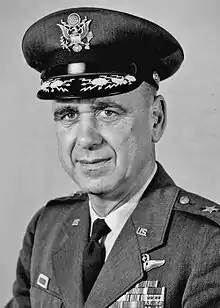Kenneth R. Powell
Kenneth R. Powell (1915 – September 16, 1987) was a United States Air Force general.

Early life
After birth in 1915 and a short stay in Oregon, his parents moved to Bozeman, Montana. Then in 1921 his family again moved with him to Tacoma, Washington. In Tacoma is where he completed grammar school and graduated from Stadium High School in 1934. That fall he entered Washington State University located at Pullman, Washington. He was a varsity track letterman, an advanced ROTC candidate, and was a member of Scabbard and Blade, Crimson Circle, national senior men's honorary society, and the Phi Delta Theta fraternity. He graduated Washington State University on June 6, 1938. He was commissioned as a Second Lieutenant and joined the military.
Military Service
Education and Early Military Service
- Bachelor of Arts Degree in Sociology and Psychology, He graduated June 6, 1938
- Flight School, Kelly Field, He graduated in July 1940.
- Command and General Staff School at Fort Leavenworth, Kansas, He graduated July 1945.
- Royal Air Force Staff College, Bracknell, England, He graduated on May 1947.[1]
- Air War College, He graduated in 1952.
Pearl Harbor
During Pearl Harbor, Lieutenant Powell's first assignment with the United States Army Air Corps was to the 78th Pursuit Squadron located at Wheeler Field in Hawaii. On December 7 during the Japanese attack on Pearl Harbor, Lt. Powell was a flight leader, however, all his squadron's aircraft were either damaged or destroyed during the attack. Therefore, no members of his squadron were able to get airborne during the attack on Pearl Harbor.
Central Pacific
In 1942 he was in command of the 46th Fighter Squadron on Canton Island. Then in 1943 he was promoted to lieutenant colonel and was assigned as the deputy commander of the 15th Fighter Group. Beginning on April 21, 1944, Colonel Powell organized and activated the 21st Fighter Group. The 21st Fighter Group was set up to provide fighter protection for bomber raids against Japan in World War II.
Upon arriving at Iwo Jima, on the second day on the island and early in the morning, Colonel Powell's group was greeted by a "Bonzai" attack in their tent area by the Japanese. Several pilots died during the attack. Even Colonel Powell was injured by a hand grenade and was evacuated to a military hospital on Guam. He returned to his post as soon as he recovered from his injuries. After returning he participated in several escort missions over Japan. Eventually his unit was awarded the Presidential Unit Citation for their escort work of land-based fighters over the Japanese homeland. They were the first to do so.
Post War Service
Between 1947 and 1949 he was the commander of the Air Force Public Relations School and organized/supervised the Comptroller Course at the Air Force Special Staff School located at Craig Field in Alabama. Next, from 1949 to 1951 Powell was the deputy commandant of the Armed Forces Information School in New York. Next, Colonel Powell was assigned as chief of the Airmen's Assignment Division in the Directorate of Military Personnel, Headquarters of the U.S. Air Force in 1952.
Then, between July 1955 to July 1959, Colonel Powell commanded the 10th Tactical Reconnaissance Wing of Spangdahlem Air Base, Germany. While in Germany on his overseas tour, he was awarded the Honor Shield of the German State of Rheinland-Pfalz for his work in promoting German-American relations. This was the first time the Honor Shield was awarded to an American military commander. The grand duchess of Luxembourg awarded Colonel Powell their highest decoration for foreign officers, the Officer's Cross in the Order of LaCouronne de Chene.
In 1959 Colonel Powell received the Legion of Merit. The citation stated in part: "Colonel Powell demonstrated outstanding qualities of leadership, diplomacy and statesmanship in establishing and directing an exceptional program of international friendship and understanding with the populace of the Federal German Republic and the Grand Duchy of Luxembourg. His efforts have greatly enhanced the prestige and good will of the United States in this most important area."[1]
After he returned from Europe, he was assigned as the commander of the 1st Strategic Aerospace Division at Vandenberg Air Force Base in California.
Assignments
- 15th Infantry, Fort Lewis, Washington, 1938
- 78th Pursuit Squadron, Wheeler Field, Territory of Hawaii
- 46th Fighter Squadron, Canton Island
- 15th Fighter Group
- 21st Fighter Group, June 15, 1944 – October 10, 1946
- Dover Air Base, Delaware, Commander, 1946
- Air Show Unit, Tactical Air Command, Langley Field, Virginia, 1946
- Spangdahlem Air Base, Germany, July 1955 - July 1959
- Vandenberg Air Force Base, California, 1961
- Commander, 819th Strategic Aerospace Division, Dyess Air Force Base, Texas, 14 May 1964 - 2 July 1966[2]
Rank History
- Second Lieutenant, June 6, 1938
- Lieutenant, 1940
- Captain, Between 1940 and 1942
- Major, 1942
- Lieutenant Colonel, 1943
- Colonel, Between 1944 and 1961
- Brigadier General, March 1961
- Major General, unknown[2]
References
- "MAJOR GENERAL KENNETH R. POWELL > U.S. Air Force > Biography Display".
- "Factsheet 819 Strategic Aerospace Division". Air Force Historical Research Agency. October 11, 2007. Archived from the original on October 30, 2012. Retrieved March 17, 2014.
![]() This article incorporates public domain material from the Air Force Historical Research Agency website http://www.afhra.af.mil/.
This article incorporates public domain material from the Air Force Historical Research Agency website http://www.afhra.af.mil/.
